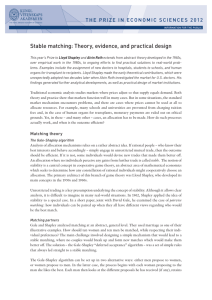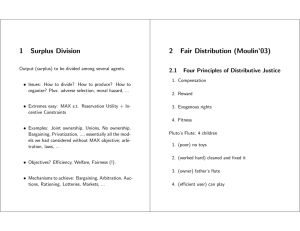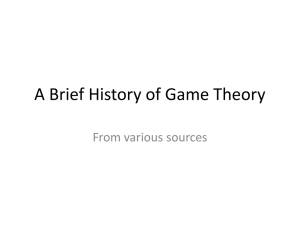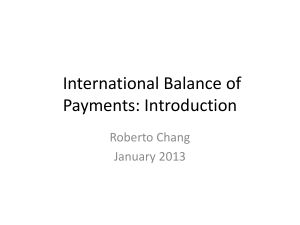Magical algorithms for matching markets: Lloyd Shapley and
advertisement
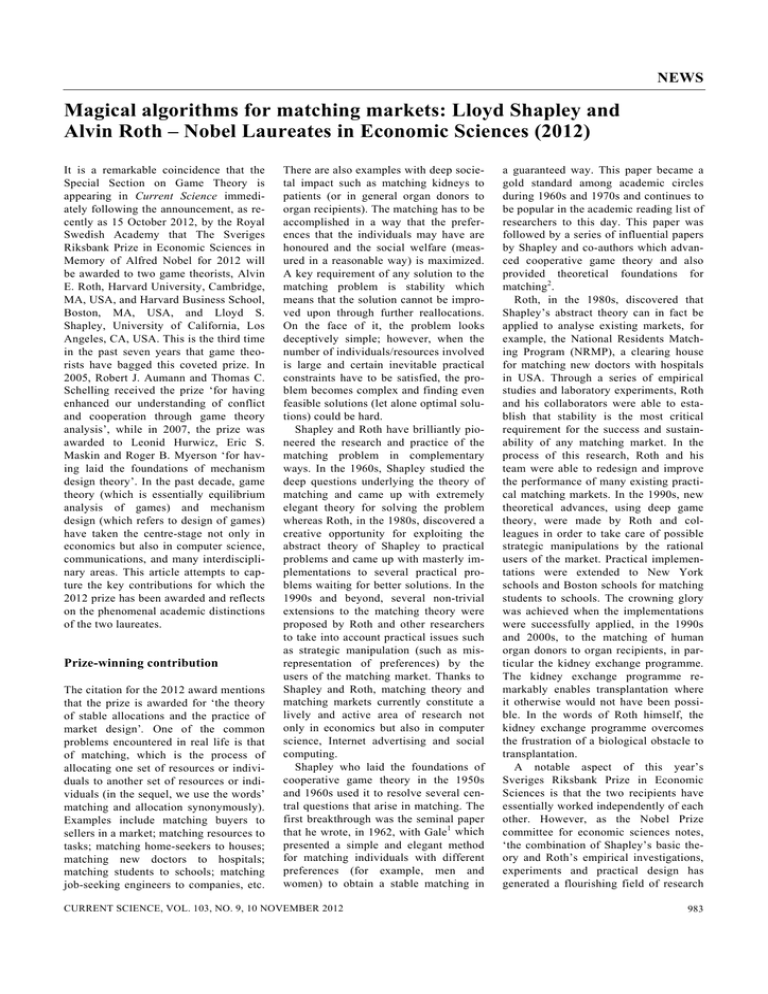
NEWS Magical algorithms for matching markets: Lloyd Shapley and Alvin Roth – Nobel Laureates in Economic Sciences (2012) It is a remarkable coincidence that the Special Section on Game Theory is appearing in Current Science immediately following the announcement, as recently as 15 October 2012, by the Royal Swedish Academy that The Sveriges Riksbank Prize in Economic Sciences in Memory of Alfred Nobel for 2012 will be awarded to two game theorists, Alvin E. Roth, Harvard University, Cambridge, MA, USA, and Harvard Business School, Boston, MA, USA, and Lloyd S. Shapley, University of California, Los Angeles, CA, USA. This is the third time in the past seven years that game theorists have bagged this coveted prize. In 2005, Robert J. Aumann and Thomas C. Schelling received the prize ‘for having enhanced our understanding of conflict and cooperation through game theory analysis’, while in 2007, the prize was awarded to Leonid Hurwicz, Eric S. Maskin and Roger B. Myerson ‘for having laid the foundations of mechanism design theory’. In the past decade, game theory (which is essentially equilibrium analysis of games) and mechanism design (which refers to design of games) have taken the centre-stage not only in economics but also in computer science, communications, and many interdisciplinary areas. This article attempts to capture the key contributions for which the 2012 prize has been awarded and reflects on the phenomenal academic distinctions of the two laureates. Prize-winning contribution The citation for the 2012 award mentions that the prize is awarded for ‘the theory of stable allocations and the practice of market design’. One of the common problems encountered in real life is that of matching, which is the process of allocating one set of resources or individuals to another set of resources or individuals (in the sequel, we use the words’ matching and allocation synonymously). Examples include matching buyers to sellers in a market; matching resources to tasks; matching home-seekers to houses; matching new doctors to hospitals; matching students to schools; matching job-seeking engineers to companies, etc. There are also examples with deep societal impact such as matching kidneys to patients (or in general organ donors to organ recipients). The matching has to be accomplished in a way that the preferences that the individuals may have are honoured and the social welfare (measured in a reasonable way) is maximized. A key requirement of any solution to the matching problem is stability which means that the solution cannot be improved upon through further reallocations. On the face of it, the problem looks deceptively simple; however, when the number of individuals/resources involved is large and certain inevitable practical constraints have to be satisfied, the problem becomes complex and finding even feasible solutions (let alone optimal solutions) could be hard. Shapley and Roth have brilliantly pioneered the research and practice of the matching problem in complementary ways. In the 1960s, Shapley studied the deep questions underlying the theory of matching and came up with extremely elegant theory for solving the problem whereas Roth, in the 1980s, discovered a creative opportunity for exploiting the abstract theory of Shapley to practical problems and came up with masterly implementations to several practical problems waiting for better solutions. In the 1990s and beyond, several non-trivial extensions to the matching theory were proposed by Roth and other researchers to take into account practical issues such as strategic manipulation (such as misrepresentation of preferences) by the users of the matching market. Thanks to Shapley and Roth, matching theory and matching markets currently constitute a lively and active area of research not only in economics but also in computer science, Internet advertising and social computing. Shapley who laid the foundations of cooperative game theory in the 1950s and 1960s used it to resolve several central questions that arise in matching. The first breakthrough was the seminal paper that he wrote, in 1962, with Gale1 which presented a simple and elegant method for matching individuals with different preferences (for example, men and women) to obtain a stable matching in CURRENT SCIENCE, VOL. 103, NO. 9, 10 NOVEMBER 2012 a guaranteed way. This paper became a gold standard among academic circles during 1960s and 1970s and continues to be popular in the academic reading list of researchers to this day. This paper was followed by a series of influential papers by Shapley and co-authors which advanced cooperative game theory and also provided theoretical foundations for matching2. Roth, in the 1980s, discovered that Shapley’s abstract theory can in fact be applied to analyse existing markets, for example, the National Residents Matching Program (NRMP), a clearing house for matching new doctors with hospitals in USA. Through a series of empirical studies and laboratory experiments, Roth and his collaborators were able to establish that stability is the most critical requirement for the success and sustainability of any matching market. In the process of this research, Roth and his team were able to redesign and improve the performance of many existing practical matching markets. In the 1990s, new theoretical advances, using deep game theory, were made by Roth and colleagues in order to take care of possible strategic manipulations by the rational users of the market. Practical implementations were extended to New York schools and Boston schools for matching students to schools. The crowning glory was achieved when the implementations were successfully applied, in the 1990s and 2000s, to the matching of human organ donors to organ recipients, in particular the kidney exchange programme. The kidney exchange programme remarkably enables transplantation where it otherwise would not have been possible. In the words of Roth himself, the kidney exchange programme overcomes the frustration of a biological obstacle to transplantation. A notable aspect of this year’s Sveriges Riksbank Prize in Economic Sciences is that the two recipients have essentially worked independently of each other. However, as the Nobel Prize committee for economic sciences notes, ‘the combination of Shapley’s basic theory and Roth’s empirical investigations, experiments and practical design has generated a flourishing field of research 983 NEWS and improved the performance of many markets. This year’s prize is awarded for an outstanding example of economic engineering’3. Clearly, the matching problem and its solutions developed by Shapley, Roth and other researchers are relevant to many problems that plague the society today. Solutions to many problems in healthcare, agriculture, education, employment, human resource development, public distribution and almost every sector could be investigated using matching theory. This applies to many existing problems in India. For example, matching theory can be used to benefit agricultural farmers by matching them in an optimal and stable way to potential buyers of agricultural produce. Lloyd S. Shapley Lloyd S. Shapley Shapley can be considered as one of the most influential game theorists of all time. He has made numerous pioneering contributions which have created new areas in game theory. He is regarded as the principal architect of cooperative game theory. Many concepts, lemmas and theorems have in fact, deservingly been named after him. These include the famous Shapley value4, which is perhaps the most popular solution concept in cooperative game theory. Given a cooperative game, the Shapley value provides a unique allocation vector that summarizes in a principled way the likely end result of the complex process of negotiations and bargaining among the players of the 984 game. Others include: (a) Bondareva– Shapley theorem which provides a necessary and sufficient condition for the non-emptiness of the core of a coalitional game and which also implies that convex games have non-empty cores. (b) Gale– Shapley theorem1 which provides by far the most used solution to the matching problem. (c) Aumann–Shapley pricing that pioneered the pricing of products and services. (d) Shapley–Folkmann lemma which settled the question of convexity of addition of sets. (e) Shapley–Shubik power index for determining voting power. Moreover, stochastic games were first proposed by Shapley5 as early as 1953. Potential games which are extensively used by researchers these days were proposed by Monderer and Shapley6 in 1996. Shapley’s joint work with Maschler and Peleg on the kernel and the nucleolus in cooperative game theory is pathbreaking, so also his work with Aumann on non-atomic games and on long-term competition. Shapley was born in 1923 in Cambridge, Massachusetts and was a child prodigy in mathematics. He joined Harvard University for his undergraduate studies and got his A.B. degree in 1948. During 1943–45, he worked for the American Military and as a Sergeant in the Army Corps in 1943, he brilliantly broke the Soviet weather code and was decorated with a Bronze star at the age of 20. He started working with Albert Tucker at Princeton University in 1949 and got his Ph D in 1953. The work on what is now called the Shapley value4 was carried out during this period. John Nash (Nobel laureate in economic sciences in 1994) and Shapley were contemporaries working with Tucker. From 1954 to 1981, Shapley spent 27 years at the Rand Corporation as research mathematician and produced many pathbreaking results. Since 1981, he has been at the University of California, Los Angeles, working in the Department of Economics as well as the Department of Mathematics. taught at the University of Illinois and the University of Pittsburg during 1982– 98. In 1998, he joined Harvard University where he is George Gund Professor of Economics and Business Administration in the Harvard Business School. He is currently a visiting Professor at Stanford University. Roth is a recipient of numerous honours, including the Alfred P. Sloan Fellowship, Guggenheim Fellowship, Fellowship of the American Academy of Arts and Sciences, and membership of the National Bureau of Economic Research and the Econometric Society. Alvin Elliot Roth Besides matching markets7,8, Roth has made pioneering contributions to game theory and experimental economics. One of his interesting contributions (1977) has been to characterize the Shapley value as a risk-neutral utility function on the space of cooperative games. In fact, Roth has himself admitted in a recent interview that he is a big fan of Shapley’s work. An excerpt from this interview is quoted here9: Alvin Elliot Roth ‘[Allegra Grevelius (interviewer)] 1988 you wrote a book called Shapley Value, Essays in Honour Lloyd S. Shapley. How did his work fluence you? In the of in- Roth was born on 19 December 1951. His first degree was in operations research at Columbia University. He completed his M S in 1973 and Ph D in 1974, both from Stanford University, again in operations research. During 1975–82, he [Alvin Roth] Well, so ... Lloyd Shapley and David Gale, um, developed the first clear theory of what’s called stable matching and they thought about algorithms. They really wrote a, they didn’t think about it that way at the time, but CURRENT SCIENCE, VOL. 103, NO. 9, 10 NOVEMBER 2012 NEWS they really wrote a very early market design paper and I've been a big follower of theirs in the sense that I wrote a book with Oliveira Sotomayor in 1990 that was called Two Sided Matching it sort of followed up the developments in the intervening 30 years in the theory of those kinds of markets. So I’m a, so I’m a, you know, I’m a big follower of Lloyd’s and it’s going to be a great honour to get the Prize together with him.’ Roth has made influential contributions to experimental economics which are well explained in the scientific background document compiled by the Nobel Prize Committee10. Roth’s work essentially shows that the explanatory and predictive power of game theory can be enhanced with carefully and skilfully designed economic and laboratory experiments. Double delight Many research problems attempted by students and researchers at the Department of Computer Science and Automation (CSA), Indian Institute of Science, Bangalore have been inspired by the contributions of Shapley. Several papers have been recently written by IISc researchers applying the notion of Shapley value to a wide variety of problems. The Gale–Shapley algorithm and the match- ing problem form the basis for two Ph D theses in the department in recent times. One of the hot debates in the Game Theory Lab in CSA every year, during the first two weeks of October, has been on who will win the Sveriges Riksbank Prize in Economic Sciences. For the past several years, one name that has consistently come up as a favourite is that of Lloyd Shapley. So when Shapley finally got the prize this year, it was celebration time in the Game Theory Lab. Further, members of the Game Theory Lab have been avid followers of Roth’s influential blog on market design11 and his highly popular survey articles. So, when Roth was named as the other recipient of the award, it was a double delight for everyone in the Lab. 1. Gale, D. and Shapley, L. S., Am. Math. Mon., 1962, 69, 9–15. 2. Roth, A. E. (ed.), The Shapley Value: Essays in Honor of Lloyd S. Shapley, Cambridge University Press, 1988. 3. Economic Sciences Prize Committee of the Royal Swedish Academy of Sciences. Stable matching: theory, evidence, and practical design. The Prize in Economic Sciences 2012, Information for the Public, October 2012; http://www.nobelprize.org/nobel_prizes/economics/laureates/2012/popular.html 4. Shapley, L. S., In Contributions to the Theory of Games (eds Kuhn, H. W. and 5. 6. 7. 8. 9. 10. 11. Tucker, A. W.), Princeton University Press, Princeton, NJ, USA, 1953, vol. 2. Shapley, L. S., Proc. Natl. Acad. Sci. USA, 1953, 39, 1095–1100. Monderer, D. and Shapley, L. S., Games Econ. Behav., 1996, 14, 124–143. Roth, A. E. and Sotomayor, M., Two Sided Matching: A Study in Game Theoretic Modeling and Analysis, Econometric Society Monograph Series, Cambridge University Press, 1990. Roth, A. E., Econ. J., 2008, 118, 285– 310. Interview with Alvin Roth, October 2012; http://www.nobelprize.org/nobel_prizes/ economics/laureates/2012/roth-interview. html Economic Sciences Prize Committee of the Royal Swedish Academy of Sciences. Stable allocations and the practice of market design. Scientific Background on The Sveriges Riksbank Prize in Economic Sciences in Memory of Alfred Nobel for 2012, October 2012; http://www.nobelprize.org/nobel_prizes/ economics/laureates/2012/advanced.html Roth, A. E., Market design; http://www. marketdesigner.blogspot.se Credits: The Nobel Prize website, http://www.nobelprize.org for the photographs of Lloyd Shapley and Alvin Roth. Y. Narahari, Department of Computer Science and Automation, Indian Institute of Science, Bangalore 560 012, India. e-mail: hari@csa.iisc.ernet.in IN CONVERSATION Eric Maskin Eric Maskin Photo courtesy: Cliff Moore Eric Maskin, currently at the Harvard University, is an economic theorist best known for his path-breaking work on the theory of mechanism design. For laying the foundations of this field, he shared the 2007 Nobel Prize in Economics with Leonid Hurwicz and Roger B. Myerson. He has also made stellar contributions to game theory, social choice theory, voting theory, monetary theory, contract theory, and the economics of intellectual property protection, among other areas. In an interview (e-mail) to Current Science, Maskin says ‘having fun is the best reason of all to do science’. What did you feel when you learnt about your winning the Nobel Prize? CURRENT SCIENCE, VOL. 103, NO. 9, 10 NOVEMBER 2012 I was delighted but very surprised by the news. When did you get interested in economic theory and game theory? I was a math major in college but, almost by accident, took a course on information economics with Kenneth Arrow. It was that course that really got me interested in economics. Did you get to interact with earlier Nobel laureates in Economics like John Nash and others early in your career? I didn’t meet John Nash until much later. But I had the privilege of studying under Nobel laureate Kenneth Arrow as a stu985
